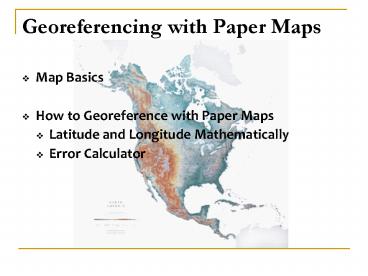Georeferencing with Paper Maps - PowerPoint PPT Presentation
1 / 46
Title:
Georeferencing with Paper Maps
Description:
Georeferencing with Paper Maps Map Basics How to Georeference with Paper Maps Latitude and Longitude Mathematically Error Calculator Pros and Cons of Paper Maps Pros ... – PowerPoint PPT presentation
Number of Views:135
Avg rating:3.0/5.0
Title: Georeferencing with Paper Maps
1
Georeferencing with Paper Maps
- Map Basics
- How to Georeference with Paper Maps
- Latitude and Longitude Mathematically
- Error Calculator
2
Pros and Cons of Paper Maps
- Pros
- Some features, such as topographic contours may
only be found on printed maps. - Old paper maps may be the only option for
obtaining coordinates for historic localities - Expedition maps may be annotated with exact
locations of events. - Cons
- Time-consuming
- Good quality paper maps may be hard to find
- Map printing errors (sometimes intentional)
3
Map of Canadas Wonderland, N of Toronto, Canada
4
(No Transcript)
5
Map Basics
- Projection
- Map Anatomy
- Scale
- Grid
- Datum
- Citing Map as Georeferencing Source
6
Projection
- A map projection is a method used to convert a
3D surface into 2D. - All methods involve compromises to preserve
area, linear distance, or shape. - Which compromise is right?
7
Projection
Geographic preserves NS distance
Mercator preserves shape (terrible for poles,
distorts area)
8
Projection
Winkel Tripel (NGS solution) reduced distortion
in both area and distance
9
Projection
- Butterfly map Cahill 1909
- Emphasis on symmetry
- Preserves area, shape
- Contiguous land masses
10
Projection Regional
Squat California (Geographic) vs. Equal-Area
California (Teale Albers)
11
The Paper Map
12
Map Anatomy Map Scale
13
Map Anatomy Map Scale
- Usually recorded as a ratio, such as 1100000, or
a fraction, such as 1/100000 - Large scale maps, such as 1/10000, show finer
detail, less area - Small scale maps, such as 1/500000, show less
detail, greater area - Think of large and small scale as how big the
fraction is. - Example 1/10000 gt 1/500000
14
Map Anatomy 125000 Large Scale
15
Map Anatomy 1250000
16
Map Anatomy 1500000
17
Map Anatomy 11000000 Small Scale
18
Map Anatomy Grid
19
Map Anatomy Grid
Map with no grid
20
Map Anatomy Grid
- Can have more than one grid system on a map
(e.g., UTM and latitude and longitude) - Shows placement of parallels and meridians
- Maps without grids cannot be used to determine
coordinates only extents
21
Universal Transverse Mercator
22
The Grid
UTM Northings
UTM Eastings
23
Map Anatomy Datum
Map with no grid labeled
24
Map Anatomy Datum
- Usually found near the map scale or publishers
name - Use Horizontal Datum, not Vertical Datum
- If ellipsoid is given instead of a datum then one
can choose a comparable datum using the pdf
document found at http//earth-info.nga.mil/GandG/
publications/tr8350.2/wgs84fin.pdf (Use Appendix
B)
25
Georeferencing Source Data
- For georeferencing, sources should include
- Publisher name
- Map Date
- Map Scale
- Map name
- Examples
- USGS 15 Topographic Series Boone 1956
- USGS Topoquad 124000 Key West 1962
26
Paper Maps
- Paper often have more detail than other sources
- Especially useful for distances by roads and
topographic features like rivers and mountain
ranges - Pay special attention to the grid lines and the
hemisphere when reporting in decimal degrees
27
Coordinate Signs for Hemispheres
28
Determining Coordinates from Paper Maps Ye Olde
Method
Nauru Island, Pacific Islands Geographic
Society, 1960 112,000
29
Determining Coordinates from Paper Maps Latitude
30
Determining Coordinates from Paper Maps Latitude
S
31
Determining Coordinates from Paper Maps Longitude
32
Determining Coordinates from Paper Maps Longitude
E
33
Determining Coordinate Precision
Determining Coordinate Precision for the
Georeferencing Calculator The smallest
measurement using our rulers is 1 mm ( 0.1 cm),
therefore we need to convert millimeters to
minutes 0.1 cm x (2 minutes/14 cm) 0.014
min Choose the next largest fraction of a minute
on the calculator. For 0.014 minutes, select 0.1
minutes.
34
Determining Coordinates from Paper Maps Error
Calculation
35
Determining Coordinates from Paper Maps The
Georeferencing Calculator Method
- Locality Description Bebedero
- We need
- One set of known coordinates
- Measuring tool
36
Determining Coordinates from Paper Maps
1. Find locality and known coordinates.
37
Determining Coordinates from Paper Maps
2. Measure distance in both directions from the
known location to the center of the named place.
118 mm East
X
83 mm North
38
3. Use calculator to convert map measurements to
real-world distances.
39
4. Calculate to determine new coordinates
40
5. Verify new coordinates
41
6. Promote coordinates to make the named place a
new starting point.
42
7. Use calculator to determine error only.
43
8. Account for measurement error.
44
9. Calculate for coordinate uncertainty (Max.
Error).
45
In Conclusion
- Pay attention to cardinal directions and
hemispheres - Measure from the center to the edge of the
feature to get the extent - Plot your coordinates to double check your work
- Explain any decisions you had to make in the
georeferenceRemarks field - Explain any errors in the locality description in
the locality errors field
46
- For Georeferencing Source be sure to include the
following - Publisher name
- Map Date
- Map Scale
- Map name
- Example United States Geological Society (USGS)
Topographic Map California, 1956, map scale
124,000, map name Boone - Determining Lat and Long
- Determining Coordinate Precision
0.1 cm x (2 minutes/14 cm) 0.014 min Round up
to 0.1 minute precision































